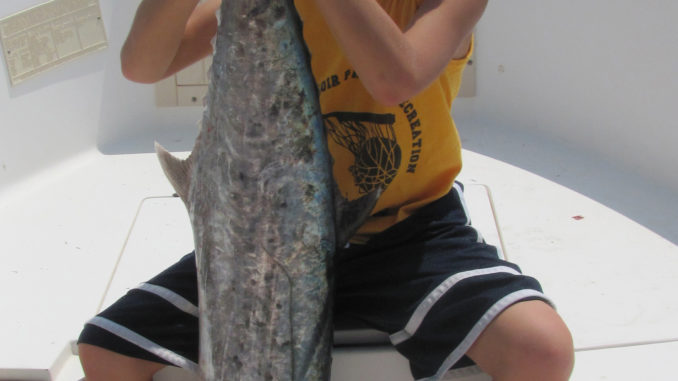
King mackerel and false albacore are Cape Lookout royalty this month. Here’s how to wear the crown for at least a little while.
King Albert I took the throne of Belgium in December 1909. King Albert II became Belgium’s monarch during the summer of 1993. That’s nothing. Kings and alberts become fishing royalty in the Cape Lookout area every fall, and there’s no need for a coronation.
King mackerel and false albacore, aka “fat alberts” are crowned by many fishermen as Thanksgiving approaches. The biggest kings and “alberts” of the year pile into the waters off Cape Lookout close to the end of October for a stay that usually lasts as long as a month. Think of 40-pound mackerel and albacore in the high “teens” and you begin to understand the urge that draws fishermen to the Morehead City/Atlantic Beach area at the peak of deer season.
“We’ll see our largest kings of the season on the east side of (Cape Lookout) shoals in November, and traditionally, November has been our best month for big albacore,” said Joe Shute, an Atlantic Beach guide and tackle shop owner. “When we get into the kings in November, they will usually be in good concentrations. The albacore will show up in good numbers earlier, but it’s the second and third weeks of November when we get our best showing of the bigger fish.”
Shute, Capt. George Beckwith of Down East Guide Service and Capt. Chris Kimrey of Mount Maker Charters know the ins and outs of catching kings and alberts as Turkey Day approaches. They’ve been figuring out ways to bring fish to their boats since before the turn of the century.
And it was in the last decade before the year 2000 that false albacore became one of the more popular fish to arrive off Cape Lookout. Often called “little tunny”, the false albacore is a member of the tuna family, but an inedible one, with oily, dark meet that is often cut up and used as chum or cut bait. Its scientific name is Euthynnus alletteratus, and it easily confused with two other football-shaped fish that show up along North Carolina’s coast: the Atlantic bonito and the skipjack tuna. The false albacore has worm-like markings on its back above the lateral line; bonito have dark stripes on its back, and skipjack tuna have dark, horizontal stripers below the lateral line.
The “albert” phenomena arrived in 1996, according to Beckwith, who said that the appearance that fall of hurricanes Bertha and Fran flushed so much fresh water through North Carolina’s coastal rivers that inshore guides had to head to the ocean to find clear, clean water. Once there, they found false albacore. Somehow, for some reason, someone hooked one on a fly rod, and the fly-fishing craze for “albies” was begun.
Beckwith (252-671-3471) refers to Cape Lookout’s fall albacore bite as “world class” and that’s understandable, with fly-rod world records seemingly within reach in several different tippet categories — though it’s a rare fish that’s half the size of the all-tackle world record, a 36-pound fish caught off the New Jersey coast five years ago.
Shute (252-240-2744) said smaller-class albacore arrive as early as late September, but it’s usually the last week of October before those 15- to 20-pound brutes show up, the ones that can spool a reel in a heartbeat.
“Alberts are a blast,” Shute said. “The bonefish is the closest thing I can think of to the way an albert fights. They’re fast and strong; they’ve got that tuna-like tail.”
Beckwith had an even better description of holding on to a big albert.
“Somebody said this to me — I can’t take credit for it — that a bonefish will pick up a fly and run away at 60 miles an hour, but an albie will hit a fly going 60 miles an hour,” said Beckwith, a trained marine biologist who said that false albacore live off the North Carolina coast year-round — sometimes just farther off than others.
“There is probably a little bit of north-south migration as well as inshore-offshore migration,” he said. “You can run into them year-round, but what fires them off in the fall is as the water cools, baitfish start exiting the sounds, and that brings the big schools of albies to the beach.”
Shute said it’s not a matter of going to an inshore wreck, reef or rock to look for albacore; all you have to do is find the bait.
“They’re all bait-related,” he said. “If the bait is in three feet of water off the beach, that’s where they’re gonna be. If it’s in 50 to 60 feet of water farther offshore, that’s where they’re gonna be. They’re going to be where the glass minnows and spearing are. You’ll find them hitting some (menhaden) and mullet, but spearing and glass minnows are what they’re after.
“And when they show up, it’s like night and day. One day, you go out and can’t find them, and the next day, they’re everywhere. It’s amazing. If we’ve got a predominant northeast wind — as we do four out of five years — it will be great.”
Shute said schools of 40 to 50 fish are common, but he’s gone out Beaufort Inlet and seen a full half-mile of water churning with thousands of albacore feeding on baitfish.
Topwater sight-casting and fly-casting has made the albacore fishery, although Beckwith said more fish can be caught below the surface, even when there’s no visible surface activity. It’s the way they crash a spoon, a piece of soft plastic or a fluff of feathers that makes them the highly desirable sportfish they are.
“They are the perfect fly-rod fish,” Beckwith said. “They will test your equipment: your knot, your fly, your rod, your drag. They will take you all the way to your backing; stripers and red drum won’t do that.”
Beckwith advises fly-fishermen to equip themselves with a 9-foot, 10-weight rod, because at times, an albert will decide to play “down and dirty” after being hooked and force an angler to derrick it up from the depths. He likes an intermediate line for most applications, a “slow-sinking striper line” but he’ll use a line with a 450- to 550-grain sink tip for fish that are down in the water column.
As for flies, he and Shute have a difference of opinion. Beckwith opts for big, colorful flies, figuring that “when you’ve got a school of 10,000 baitfish, you don’t want your fly to look like every other baitfish. Sometimes, off-the-wall colors will help, like tooti-fruity (pink-chartreuse). Beckwith doesn’t mind using huge flies. He said he normally has a 6-inch “Half-and-Half” — half-Clouser, half-Deceiver — tied on, and he said the bigger flies are normally more productive when fish are scattered and not bunched up, busting baits at the surface.
Shute is more of a match-the-hatch fly-fisherman. “The key is getting your fly the same size as the bait they’re feeding on,” he said. “If you’re throwing a 3-inch fly at them and they’re eating 1-inch spearing, they won’t bite yours. Mostly what I use is a Clouser tied on a No. 2 hook, either chartreuse/pink, white, olive/white or chartreuse/white.”
For fishermen targeting false albacore with spinning or baitcasting gear, Beckwith and Shute tend toward small casting spoons like Stingsilvers or a white/pink Zoom Fluke fished on a quarter-ounce jighead.
As far as king mackerel go, it’s a big-bait, big fish fishery, and it’s centered on bottom structure on the east side of the Cape Lookout shoals, which push the Gulf Stream’s 3-knot flow to the northeast, where eddies spin off and wind up over popular spots like the Atlas Tanker wreck, the D Wreck, Chicken Rock and the East Tanker. The magic depth is about 100 to 120 feet, but most kings will be at least halfway up in the water column.
“You can still fish on this side of the shoals at places like the 240 Rock and the 14 Buoy, but it’s easier to go over to the east side through the Knuckle Buoy. The water is deeper and warmer over there; it’s always warmer this time of the year, and you’re looking for that 66- to 70-degree water,” Shute said. “We see our larger fish in November. They start schooling up, fish from 20 to 60 pounds. Most of them are caught on live bait.”
Kimrey (252-342-0464), who specializes in mackerel fishing, said he typically heads out to one of the wrecks or rocks, but he rarely gets there, opting to stop at the first place east of the shoals where he finds a concentration of baitfish in the correct temperature range.
“If the fall, you can be running along in 70-degree water, then hit 62, then 68,” he said. “That’s what stacks them up, the edges of those temperature breaks. Plenty of times in November, I’ve been running along in nothing, and then you catch the edge of a temperature break, find a place full of bait and stop and catch fish.
“Anytime you find an eddy with bait, stop on it. If you find a place with a stark water-color change, stop there.”
Big kings are liable to stick around all the way to Christmas, if the weather holds, Shute said. Offshore fishermen have regularly caught them in 58- and 59-degree water while trolling horse ballyhoo for bluefin tuna in January, but the east side kings usually move out when the water temperature dips to around 60 degrees.
Menhaden are the popular baitfish for kings, but they’re harder to find as the water cools. Shute said most fishermen who utilize menhaden will catch them in cast nets off the beach, in the ocean. Some charter captains will have a short section of gill net they drop around a menhaden school, as getting them corralled in a net in deeper water is a most-difficult exercise.
The standard live-bait rig is built out of No. 5 wire, with a small, live-bait hook for the nose of the bait and a pair of No. 4 treble hooks either pinned into the back and/or tail of the fish of free-swinging.
Kimrey likes to fish a spread of four rods, often mixing dead ribbonfish with live baits. He’ll fish one bait down on a downrigger, approximately halfway between the surface and the bottom. He’ll fish the other three at the surface: one in the prop wash, one a decent distance behind the boat and one well behind the boat. Slow-trolling speed is anywhere from one-half to two miles per hour; you’re not trying to get anywhere in a hurry or cover water, just present baits to the fish.
“I’ll start with those four rods and make adjustments for what they want. If I’m not getting any bites on the downrigger, I’ll run four lines at the surface. And I’ll run more than one downrigger if that’s what they’re biting.”
If menhaden are difficult to come by, both Shute and Kimrey will use bluefish, catching them around inshore rocks and wrecks and using them on slightly-heavier rigs.
Bluefish: the other live bait
With menhaden more difficult to come by in the cooler waters of November, many king mackerel fishermen turn to a fish that a lot of anglers target in the summer and fall: bluefish.
“I fish bluefish and ribbonfish a lot in the fall,” said Capt. Chris Kimrey. “If it’s hard to get menhaden, one of the easiest ways to get bait for guys who fish mostly on the weekends is go to jig up some bluefish. Go to the rock jetty or some of the rocks on the east side and jig them up.
“The great thing about bluefish is, when the water’s cold, a bluefish will live all day. A lot of people who fish for kings in the summer get aggravated with bluefish because they’ll die in the livewell, but he’s a different animal in the fall.”
Kimrey ties a heavier live-bait rig to handle bluefish. He go from No. 5 to No. 6 wire, tie on a 4/0 nose hook and a pair of No. 2 4x to 6x strong treble hooks.
“I’ve fished bluefish up to 3½ pounds,” he said. “I’ve seen a 50-pound king eat a 4-pound bluefish like nothing. I think a 40-pound king can eat a 5-pound Spanish mackerel all day.”
Albacore are ready to be ‘chums’
Capt. George Beckwith said there will be days when surface action on false albacore may be lacking, with just a few scattered fish breaking.
There are more of them around, he said, they’re just feeding down in the water column. One tactic he uses to get them to the surface is chumming, using frozen glass minnows.
“A lot of times you’ll mark them on your depthfinder but they won’t be at the surface,” Beckwith said. “I get a lot more bites chumming them. If you can get them aggressive with the chum, they’ll stay with it a long time.”
Beckwith said he recognized the power of chum on false albacore on one trip when he found a big school of fish following a shrimp boat, cleaning up the by-catch as it was tossed overboard.
“We hooked one, then we started chumming, and we pulled the school away from the shrimp boat,” he said. “That’s why sometimes you don’t want all that bait around. They’ll come to chum.”
DESTINATION INFORMATION
WHERE TO GO/HOW TO GET THERE — Morehead City, Altantic Beach and Beaufort — take US 70 east from Raleigh and you’ll get there in a couple of hours — all offer access to king mackerel and false albacore hotspots through Beaufort Inlet. On certain winds, a run up behind Shackleford Banks and out Barden’s Inlet, into the hook behind Cape Lookout, can be a little easier. Getting across the Cape Lookout Shoals for kings is usually accomplished at a slough marked by the Knuckle Buoy. Best action on kings and big albacore will be from mid-October through Thanksgiving, although the length of the bite is weather dependant.
TACKLE/TECHNIQUES — For false albacore, a 9-foot, 10-weight fly rod and reel spooled with an intermediate line is needed to handle fish in the 15- to 20-pound class. Flies are streamers that imitate baitfish like glass minnows and spearing. Fishermen sight-casting with spinning or baitcasting tackle will need a selection of half-ounce casting spoons and soft-plastic baits that imitate minnows (think Fin-S and Flukes) fished on a leadhead jig.
ACCOMMODATIONS — Carteret County Chamber of Commerce, 800-622-6278 or www.nccoastchamber.com.
GUIDES/FISHING INFO — Capt. Joe Shute, 252-240-2744 or www.captjoes.com; Capt. George Beckwith’s Down East Guide Service, 252-671-3471 or www.pamlicoguide.com; Capt. Chris Kimrey, Mount Maker Charters, 252-342-0464 or www.mountmakercharters.com. See also GUIDES & CHARTERS in Classifieds.
MAPS — GMCO’s Chartbook of North Carolina, 888-420-6277 or www.gmcomaps.com; Capt. Segull’s Nautical Charts, 888-473-4855, www.captainsegullcharts.com; Sealake Fishing; Guides, 800-411-0185, www.thegoodspots.com; Grease Chart, 800-326-3567, www.greasechart.comMaps Unique, 910-458-9923, www.mapsunique.com.

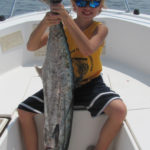
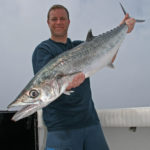
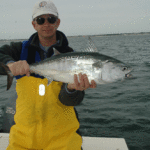
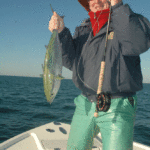
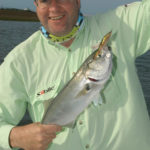
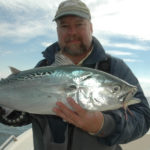
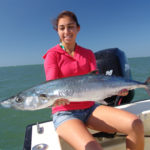

Be the first to comment